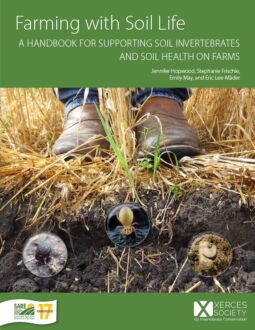ARTHROPOD SOIL MESOFAUNA (a.k.a. "mesoarthropods") are small arthropods that impact decomposition processes. They are important links in food webs—feeding on fungi, nematodes and more—and are food sources themselves for larger arthropods like beetles and ants. Mesoarthropods can be abundant in their habitats. This group indirectly influences soil structure by contributing their bodies to the organic matter of soil. Mesoarthropods are too small and numerous to count in the field, and samples are brought back to a lab in order to extract and identify mesoarthropods. Berlese funnels are often used to extract mesoarthropods from the soil, or they can be extracted by floating a sample in solvents, followed by filtering
Mites
PHYLUM: Arthropoda » CLASS: Arachnida » SUBCLASS: Acari » ORDERS: Mesostigmata, Oribatida
SIZE: 0.0024–0.2" (60 µm–5 mm).
ECOLOGICAL ROLE: Mites are critical in soil food webs as decomposers and predators. Particularly important in their role as detritivores, oribatid mites break down leaf litter into pieces accessible to smaller decomposers. Mites are also agents of bacterial and fungal dispersal.
DESCRIPTION: Mites have rounded or pear-shaped bodies with a cuticle that ranges from soft or very hard but that is typically dark in coloration. Adult mites have eight legs and larvae have six. Some species have simple eyes, while others are blind and rely on hairlike setae for sensing. One group of oribatid mites have hard shells with a hinge that opens the shell, allowing them to tuck their legs inside the shell for protection, resembling a small seed. Others have winglike projections that are not used for flight but instead shield their legs from predators.
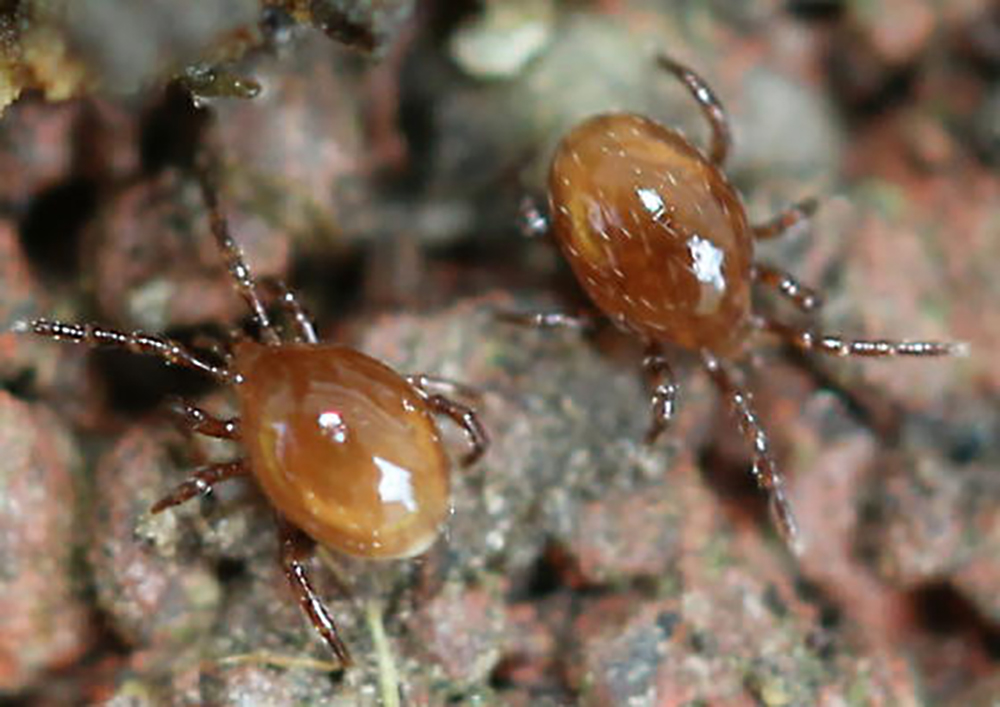
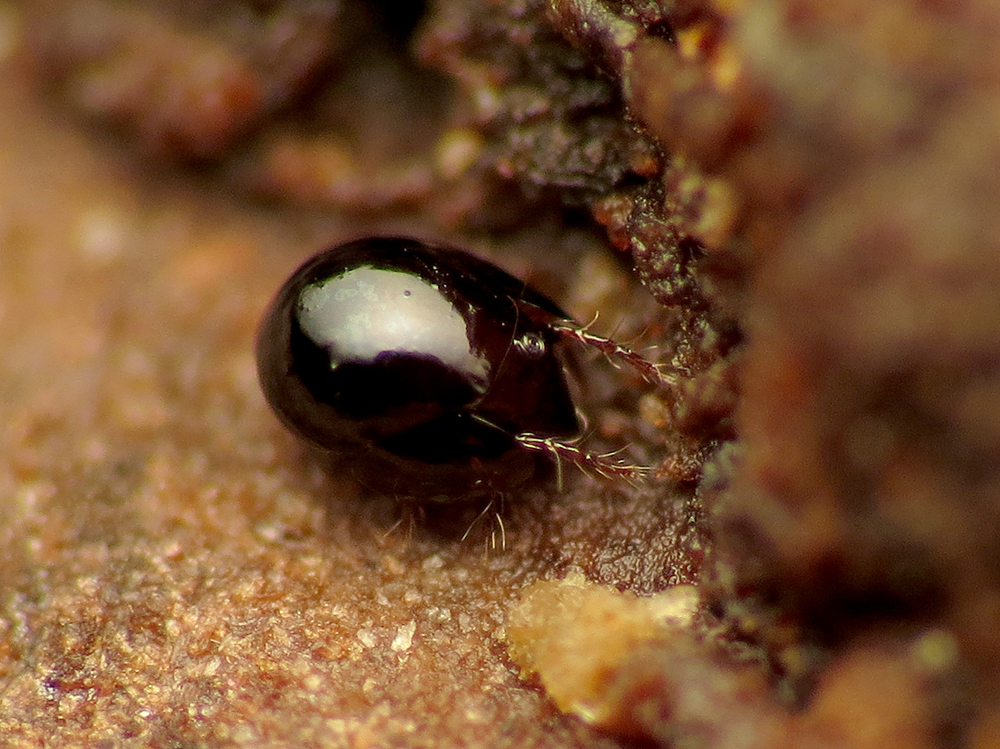
WHERE THEY ARE FOUND: Soil mites are found at the soil surface, within soil layers, and e in deep soil horizons. Mite fauna vary with soil type, and specialist soil types have uniqu mite communities. A few oribatid species are found in moss and lichen in woodlands.
WHAT THEY EAT: Oribatid mites consume bacteria, fungi, algae and dead plants and animals, while mites of the order Mesostigmata eat soil animals such as insect eggs and larvae, other mites, springtails and nematodes.
LIFE CYCLE: Mites pass through egg, prelarva, larva and several nymphal stages before becoming adults. The length of each life cycle varies significantly by species, from weeks to up to three years. Some species can reproduce by parthenogenesis, in which diploid eggs develop into female mites without fertilization.
APPROX. NUMBER OF KNOWN SPECIES: 28,000 worldwide (1,850 in North America).
RELATIVE ABUNDANCE: Among soil arthropods, mites have the most species and often the highest abundance in most types of soil. For example, about 250,000 mites can live in a square meter of moist forest soil. A 100-gram sample of soil may include as many as 500 individuals representing about 100 genera.
NOTES OF INTEREST:
- Nearly 40% of all microarthropods in the soil are mites.
- Fungi and oribatid mites seem to compete for decaying plant litter (either is dominant at a site but not both).
- An oribatid mite eats about 20% of its weight in leaf litter every day. They are essential for creating further breakdown of materials by other decomposers, and they stimulate microbial activity by dispersing bacteria and fungi. Their share in turning over soil substances is estimated to be 50%.
- Some mites can disperse to new habitats by hitching a ride on insects (e.g., clinging to the hairs of ground-nesting bees during flight, then dropping in a new location).
- Mites in the small family Nematalycidae reside in deep soil and have a more wormlike body shape.
- Non-soil-dwelling mites can be found everywhere, in all types of aquatic habitat (even hot springs and deep trenches) and terrestrial habitats, too.
- The composition of mite communities can be indicators of past vegetation and landscapes.
- Many species need to be mounted on slides in order to be identified.
- Tillage can reduce predatory mite populations in crops.
- Mites are pretty resistant to radioactivity. They can withstand doses 100× more than a lethal dose to humans.
Dwarf Millipedes (symphlans)
PHYLUM: Arthropoda » SUBPHYLUM: Myriapoda » CLASS: Symphyla
SIZE: 0.039–0.39" (1–10 mm).
ECOLOGICAL ROLE: In food webs, dwarf millipedes are decomposers, herbivores, fungivores and scavengers.
DESCRIPTION: Dwarf millipedes are white or colorless, with elongated, segmented bodies and 12 pairs of legs. They are usually eyeless but have long, beaded antennae. On their last abdominal segment, dwarf millipedes have spinnerets used to spin silk to deter predators.
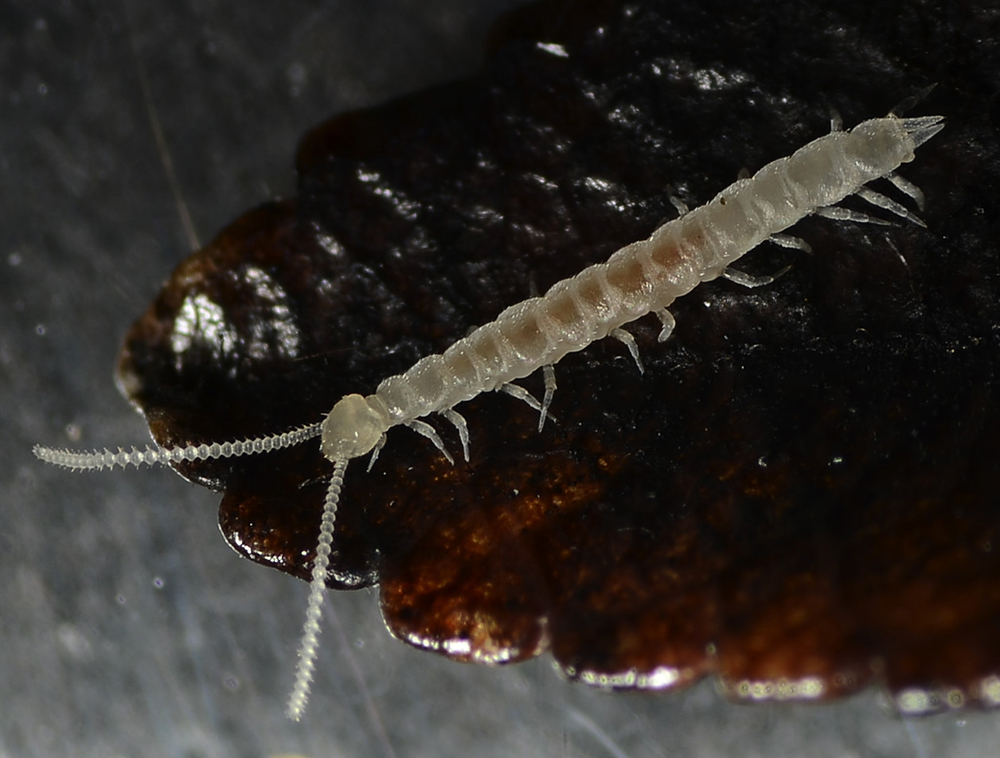
WHERE THEY ARE FOUND: Dwarf millipedes are found in deep and shallow layers of the soil, often among roots. They move through pore spaces in the soil.
WHAT THEY EAT: These myriapods feed on decaying vegetation, fungi, and dead animals, and some are root feeders.
LIFE CYCLE: Young are born with six pairs of legs and add legs as they molt. There are one or two generations per year.
APPROX. NUMBER OF KNOWN SPECIES: 200 worldwide (30 in North America).
RELATIVE ABUNDANCE: These arthropods can be locally abundant.
NOTES OF INTEREST:
- Dwarf millipedes may vertically migrate in the soil, moving with moisture as it changes through the seasons, becoming more abundant in upper layers in autumn and spring, then moving deeper in dryer summer periods.
- They possess defensive glands that secrete poison or repellants to ward off attackers. They use silk to hinder predators that may be pursuing them and to drop into crevices quickly if needed.
Pauropods
PHYLUM: Arthropoda » SUBPHYLUM: Myriapoda » CLASS: Pauropoda
SIZE: 0.02–0.08" (0.5–2 mm).
ECOLOGICAL ROLE: In food webs, pauropods are decomposers, and their ecological roles are not well understood.
DESCRIPTION: Pauropods are pale, with 11 to 12 body segments and nine to 10 pairs of legs. They are usually eyeless and have forked or branched antennae.
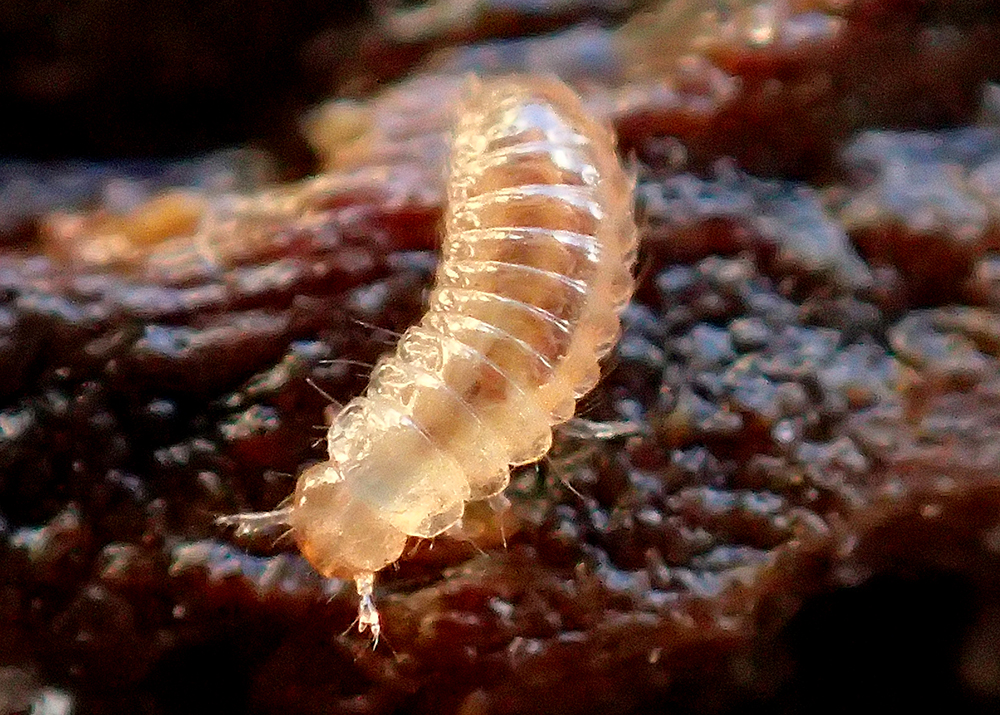
WHERE THEY ARE FOUND: Pauropods are found in soil, decaying wood, leaf litter and other moist, dark places.
WHAT THEY EAT: These myriapods feed on decaying organic matter and fungi.
LIFE CYCLE: Pauropods have separate sexes, though parthenogenesis may occur in some species. Young resemble adults and add segments and legs as they molt.
APPROX. NUMBER OF KNOWN SPECIES: 500 worldwide (100 in North America).
RELATIVE ABUNDANCE: Pauropods are not abundant (usually less than 100 per square meter).
NOTES OF INTEREST:
- This group is not well studied, and many species remain undescribed. In a 2002 study, more than 30 species were found in the Great Smoky Mountains National Park that had not yet been described, eight which were new to science.
- The best way to sample these arthropods is with a Berlese funnel.
Springtails
PHYLUM: Arthropoda » CLASS: Collembola » ORDERS: Entomobryomorpha, Neelipleona, Poduromorpha, Symphypleona »
FAMILIES: Entomobryidae, Hypogastruridae, Onychiuridae, Sminthuridae
SIZE: 0.0098–0.2" (0.25–5 mm).
ECOLOGICAL ROLE: As decomposers, springtails impact nitrogen mineralization a plant growth. Their selective consumption of fungi can also alter fungal communities and may contribute indirectly to nutrient cycling and the decomposition process.
DESCRIPTION: Springtails range in body shape from elongate to globular and compact and from white to purple to brown or gray in body color. Many have a structure that looks like a tail and extends from the back of the body; this structure, called a furcula, is held under tension beneath the abdomen until released, when it will propel the springtail on the soil surface in a short jump more than 20 times its own body length (hence their common name). Species that dwell within the soil have a reduced or absent furcula. Simple eyes are present in some species, but species that dwell deep in the soil are blind.
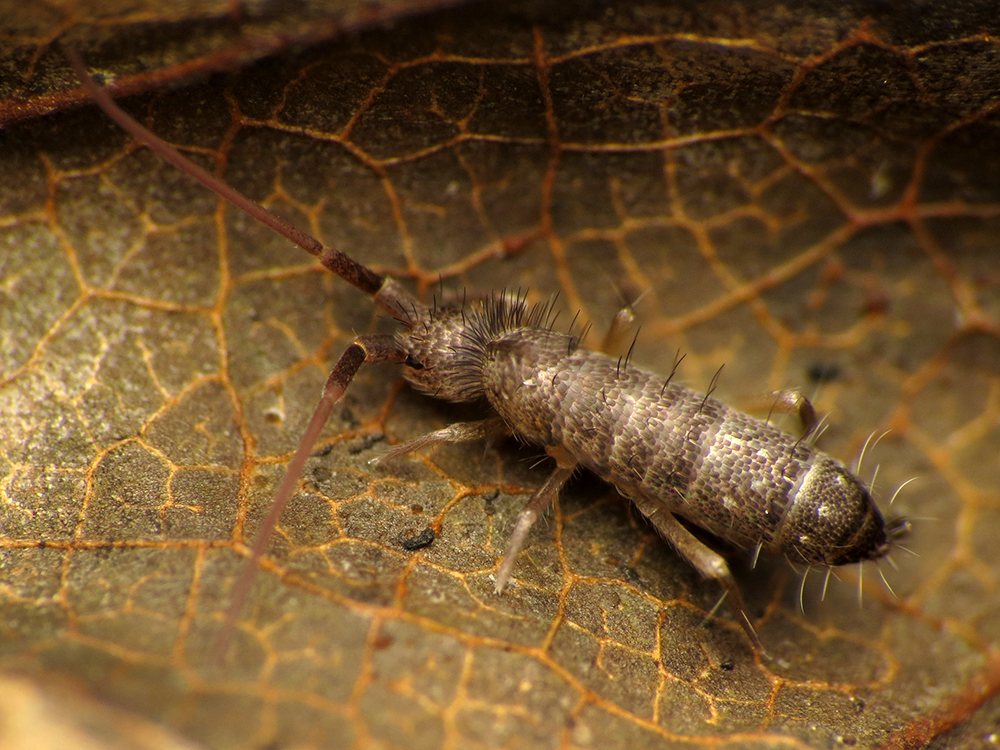
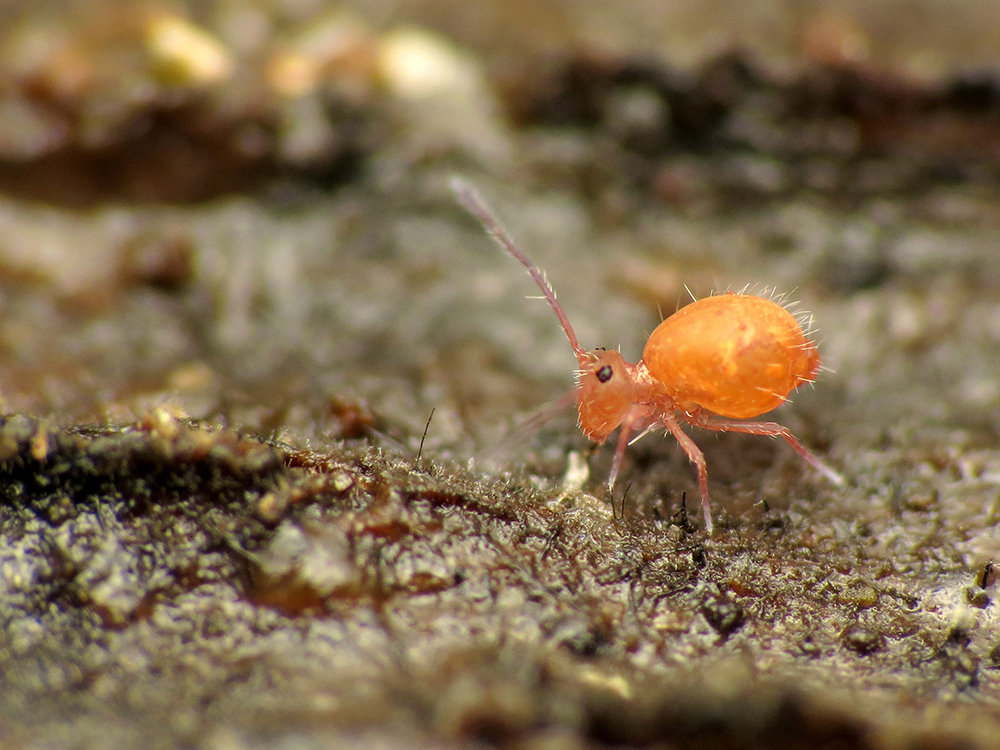
WHERE THEY ARE FOUND: Entomobryomorpha and Symphypleona springtails li soil surface litter and vegetation, decaying logs and fungi, as well as under bar Poduromorpha and Neelipleona dwell within the soil. Springtails occur in all terrestrial habitats, from deserts to rainforests to mountains to seashores, and are dominant in Arctic soils.
WHAT THEY EAT: Springtails consume decaying plants, fungi, bacteria and pollen. Some are predators of rotifers, nematodes and other springtails. A few species may consume plant roots, occasionally becoming economically damaging.
LIFE CYCLE: Springtails have simple metamorphosis but unlike insects, they continue to molt after becoming mature, with some molting up to 50 times in their life. (Arthropods must shed their skin, or molt, in order to grow. An instar is developmental stage in between molts. Maturity in springtails is usually at the fifth sixth instar.) Most are bisexual, and some species have parthenogenetic forms.
APPROX. NUMBER OF KNOWN SPECIES: 8,500 worldwide (840 in North America).
RELATIVE ABUNDANCE: Springtails can be quite abundant. Populations of 1.4 billion per acre have been estimated in some places; in temperate grasslands, up to 40,000 per square foot have been recorded.
NOTES OF INTEREST:
- Tillage can reduce populations of springtails.
- Blind springtails navigate using sensors at the base of their antennae. They also release drops of their blood from pores to deter predators, since their blood is toxic or distasteful.
- In late winter, Hypogastruridae springtails, known as snow fleas, come to the surface of melting snow.
- A springtail that is 0.12–0.24" (3–6 mm) in size can leap 3–4" (75–100 mm).
- Springtails have a tube on their belly that they extend to soak up moisture, allowing them to survive when humidity falls, since they don’t have a hard exoskeleton that prevents drying out.
- One species of springtail, Cryptopygus antarcticus, native to Australia and Antarctica, appeared on a postage stamp issued by the Falkland Island Dependencies.
- Some springtails can become wind-borne and disperse great distances. Some species can even be found on oceanic islands or coral atolls.
- Springtails preferentially fed on pathogenic fungi in a greenhouse setting, suggesting some could play a role in reducing plant stressors.
Proturans
CLASS: Protura » ORDER: Acerentomata » FAMILIES: Acerentomidae, Eosentomidae, Hesperentomidae, Protentomidae
SIZE: 0.024–0.098" (600µm–2.5 mm).
ECOLOGICAL ROLE: Proturans may play a secondary role in decomposition.
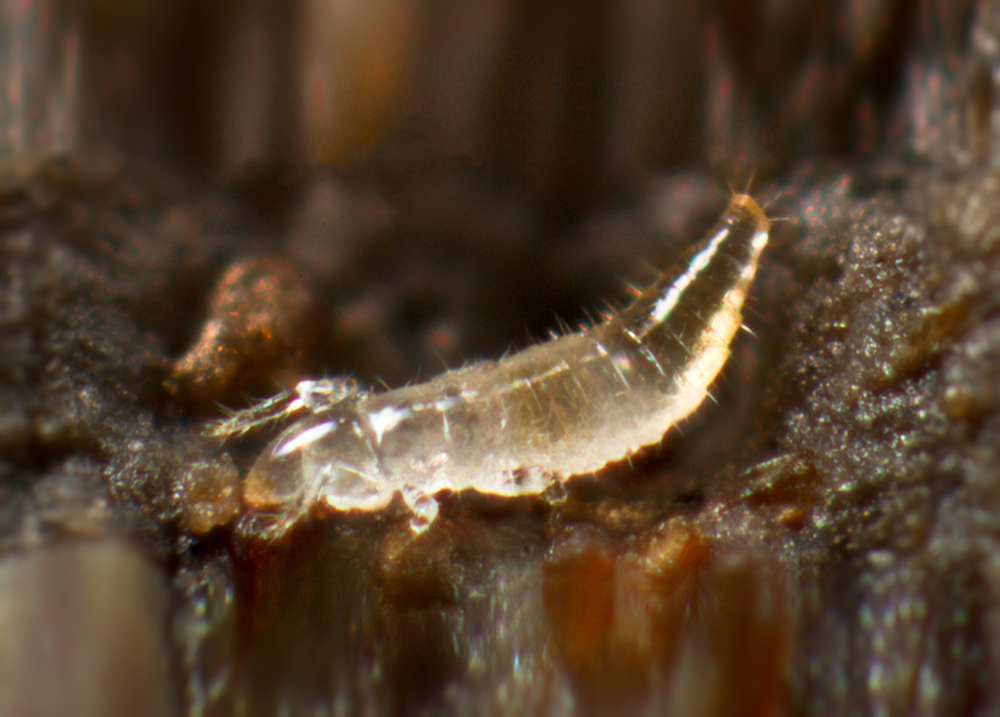
DESCRIPTION: Proturans are tiny, eyeless animals with pear-shaped heads and no visible mouthparts (mouthparts are internal). They are pale or yellow-brown in color. They have six legs but no antennae, and they walk on two pairs of legs and use their front legs as sensory organs, waving them back and forth in front of their body.
WHERE THEY ARE FOUND: Proturans live in moist soil, leaf litter or in decaying wood, as well as under bark. They can penetrate deeper soil layers, up to nearly 10" (25.4 cm). They are absent in disturbed, degraded soils.
WHAT THEY EAT: Proturans consume algae and fungi, possibly also feeding on the mycorrhizae associated with tree roots.
LIFE CYCLE: Young proturans have nine segments in their abdomens and go through three molts; adults have 12 segments.
APPROX. NUMBER OF KNOWN SPECIES: 700 worldwide (80 in North America).
RELATIVE ABUNDANCE: Proturans are not often as abundant as other microarthropods but can occur in high numbers. Upper estimates range from 1,000 to 7,000 per square meter, and density appears to depend on organic matter. As many as five million may live on a single acre (85,000 per square meter).
NOTES OF INTEREST:
- When disturbed, proturans raise their abdomen in a defensive posture (like rove beetles or scorpions); they have a pair of defensive glands at the end of their abdomen that produce a repellent to help discourage predators.
- Proturans are a food source for mites, spiders, pseudoscorpions.
Diplurans
CLASS: Diplura » ORDER: Dicellurata » FAMILIES: Campodeidae, Japygidae
SIZE: 0.079–0.79" (2–20 mm).
ECOLOGICAL ROLE: In soil food webs, diplurans are herbivores, detritivores, and predators.
DESCRIPTION: Diplurans have narrow, elongate bodies; an abdomen with 10 to 11 segments; and long, bead-like antennae. They are white or colorless. They have short legs and, at the end of their abdomen, two sensory appendages used for touch and smell, called cerci. Eyeless, their bodies are covered in sensory bristles. Diplurans in the family Campodeidae have filamentous cerci and are smaller and more delicate than other diplurans. Diplurans in the family Japygidae have pincerlike cerci at the end of their abdomens. Their wormlike wormlike body shape enables diplurans to travel in the interstitial system of the soil.
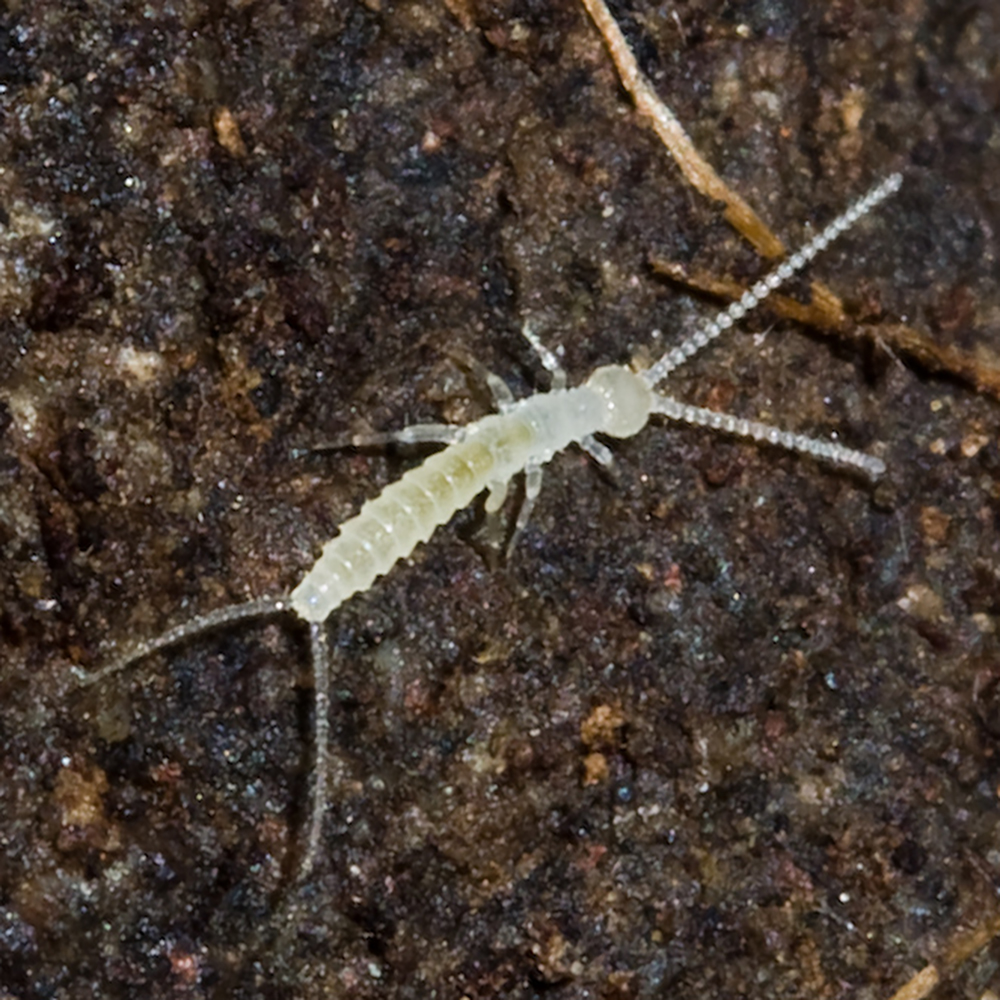
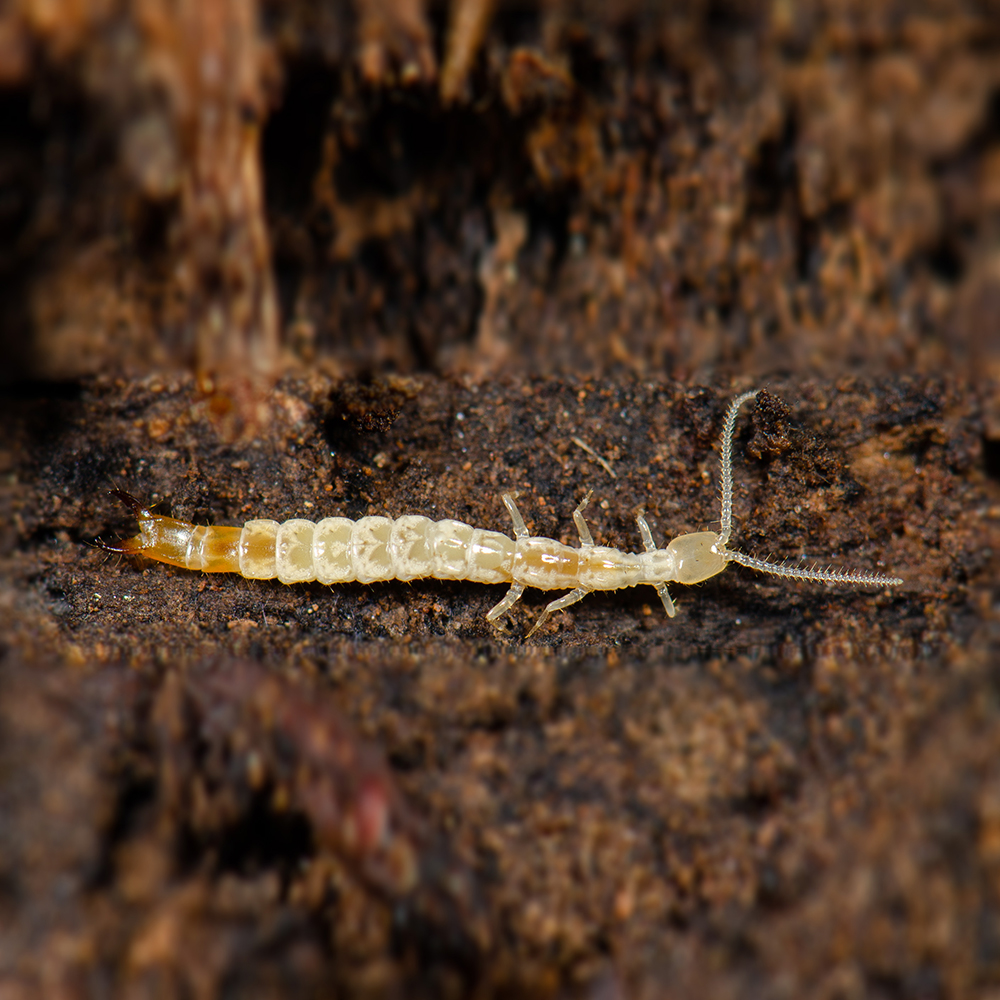
WHERE THEY ARE FOUND: Dipluran in leaf litter, moss, rotting wood, a moist areas; on the surface of soil or within the soil up to depths of 4–8" (10–20 cm); and under bark or stones
WHAT THEY EAT: Campodeids eat plant material, plants and animals that are decomposing, and fungal mycelia. Japygids eat small insects such as fly larvae, proturans springtails and nematodes.
LIFE CYCLE: Molting continues throughout their lives. Males deposit sperm in capsules on the ground that females pick up; females lay eggs in a mass or clump in cracks or in cavities in the ground.
APPROX. NUMBER OF KNOWN SPECIES: 800–1,000 worldwide (100 in North America).
NOTES OF INTEREST:
- Blind japygids detect prey using sensory hairs on their antennae—they grasp prey in their mouthparts before bending their abdomen over their head to seize prey with their pincers.
- Japygid females protect their eggs and larvae.
- Japygids are territorial and will make barriers to outline their boundaries.
Bristletails
CLASS: Insecta » ORDER: Microcoryphia
SIZE: 0.079–0.59" (2–15 mm).
ECOLOGICAL ROLE: Bristletails are scavengers in soil food webs, cleaning up plant and animal matter.
DESCRIPTION: Bristletails are wingless, with a humpback profile, long antennae and large, compound eyes. Their bodies are covered with scales and are light gray to brown in color, and they have four long, taillike appendages.
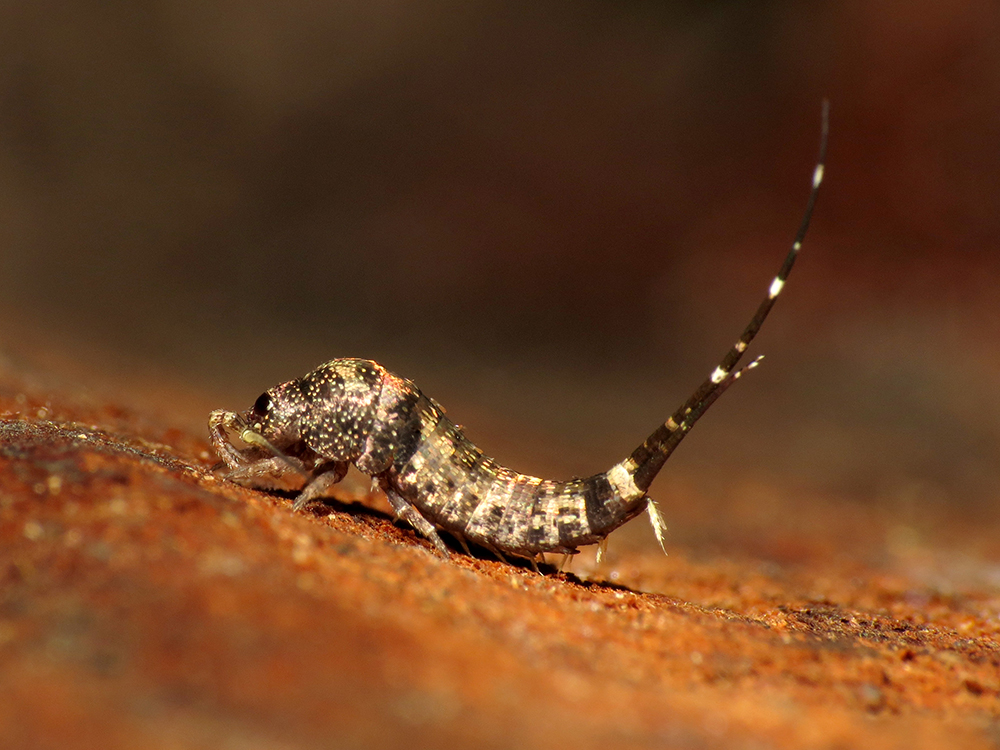
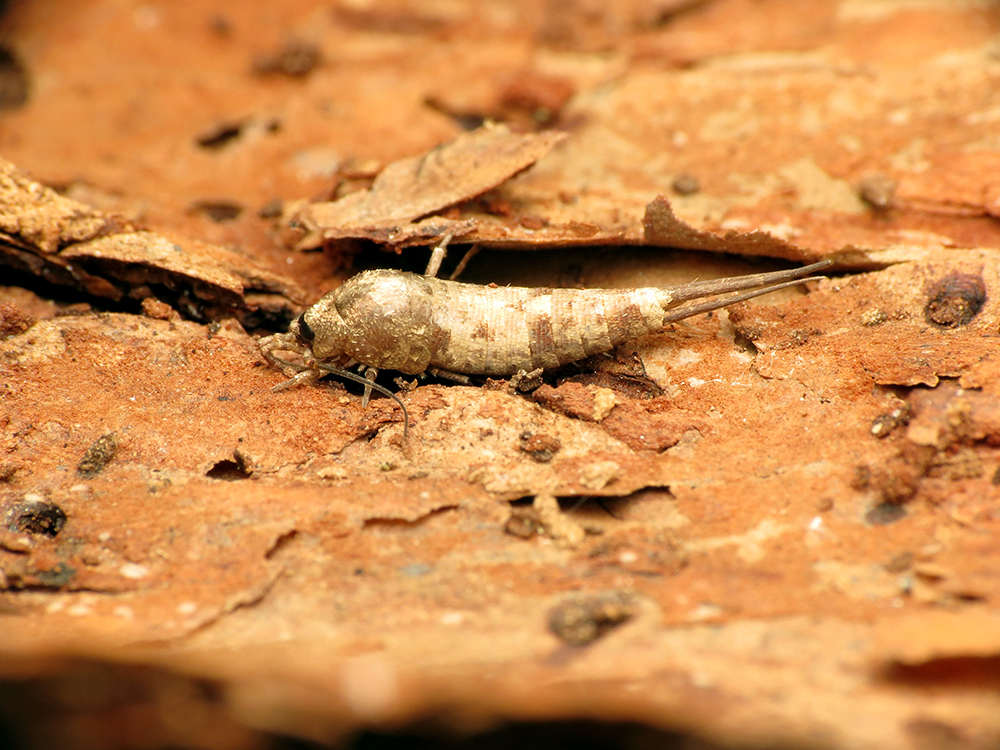
WHERE THEY ARE FOUND: Bristletails occur in soil and leaf litter, in dead wood, under bark or dead wood, or under rocks.
WHAT THEY EAT: Bristletails feed at night on algae, fungi, plant detritus, decaying fruit, lichens, mosses and dead arthropods.
LIFE CYCLE: These insects have simple metamorphosis, and over the course of their lives lasting two to four years they may molt as many as 60 times. They attach themselves to a rock or stick using fecal material before they molt; if their cement fails before the molt is complete, they often do not survive the molting process. Females may mate every instar after their tenth, attaching their eggs to a substrate, like a rock.
APPROX. NUMBER OF KNOWN SPECIES: 350 worldwide (20 in North America).
RELATIVE ABUNDANCE: Bristletails do not usually occur in high densities—approaching 50 per square meter.
NOTES OF INTEREST:
- Bristletails have complex courtship rituals. After identifying mates using their antennae, males of some species place packages of sperm, called spermatophores, directly on a female, while males of other species spin a fine thread to which they attach their sperm packets and wait for the females to retrieve.
- Bristletails are fast runners and can jump randomly by arching their body and slapping their abdomen to fling to safety. They can jump as far as 12" (30 cm).
- Many bristletails are nocturnal, and their eyes glow at night in the beam of a flashlight.
- Bristletails are the closest living relatives to winged insects.
Thrips
PHYLUM: Arthropoda » CLASS: Insecta » ORDER: Thysanoptera
SIZE: 0.02–0.2" (0.5–5 mm).
ECOLOGICAL ROLE: In the soil and leaf litter, thrips are fungivores or predators. Other thrips species are plant feeders and may act as vectors of plant diseases or damage agricultural crops.
DESCRIPTION: Thrips have small, slender, dark bodies and conical heads with piercing, sucking mouthparts and short antennae. Wings, when present, are long and very narrow fringes of hairs.
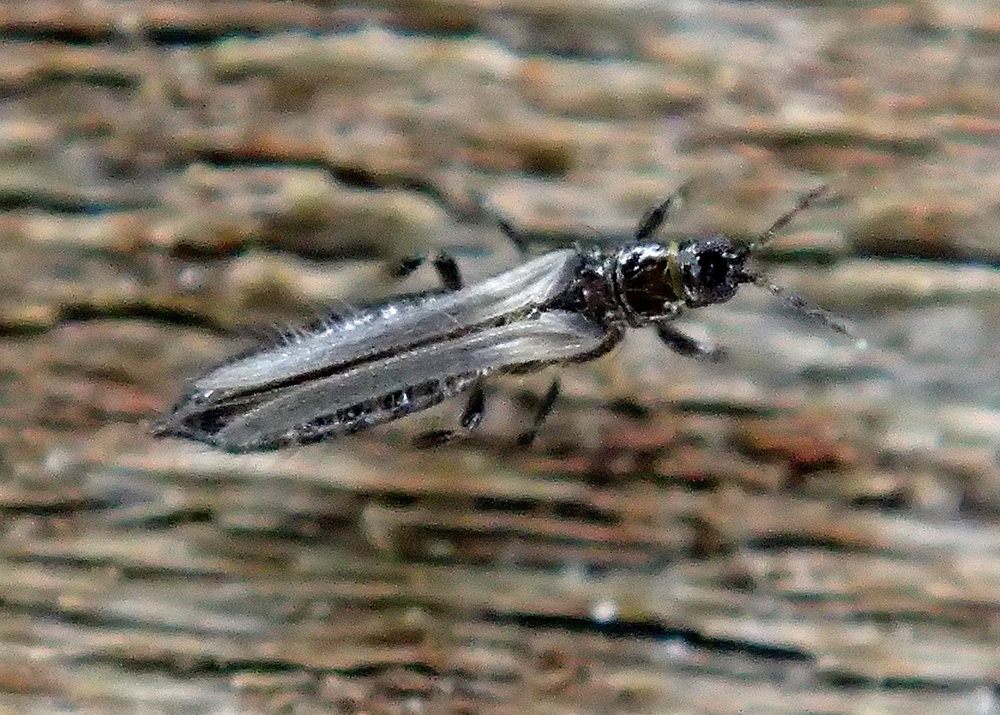
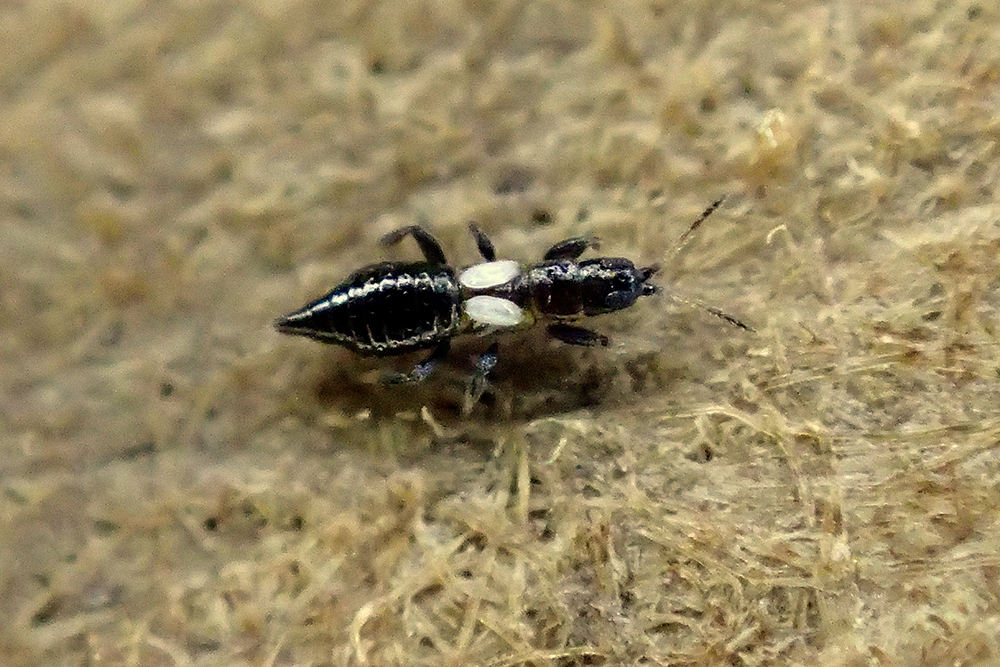
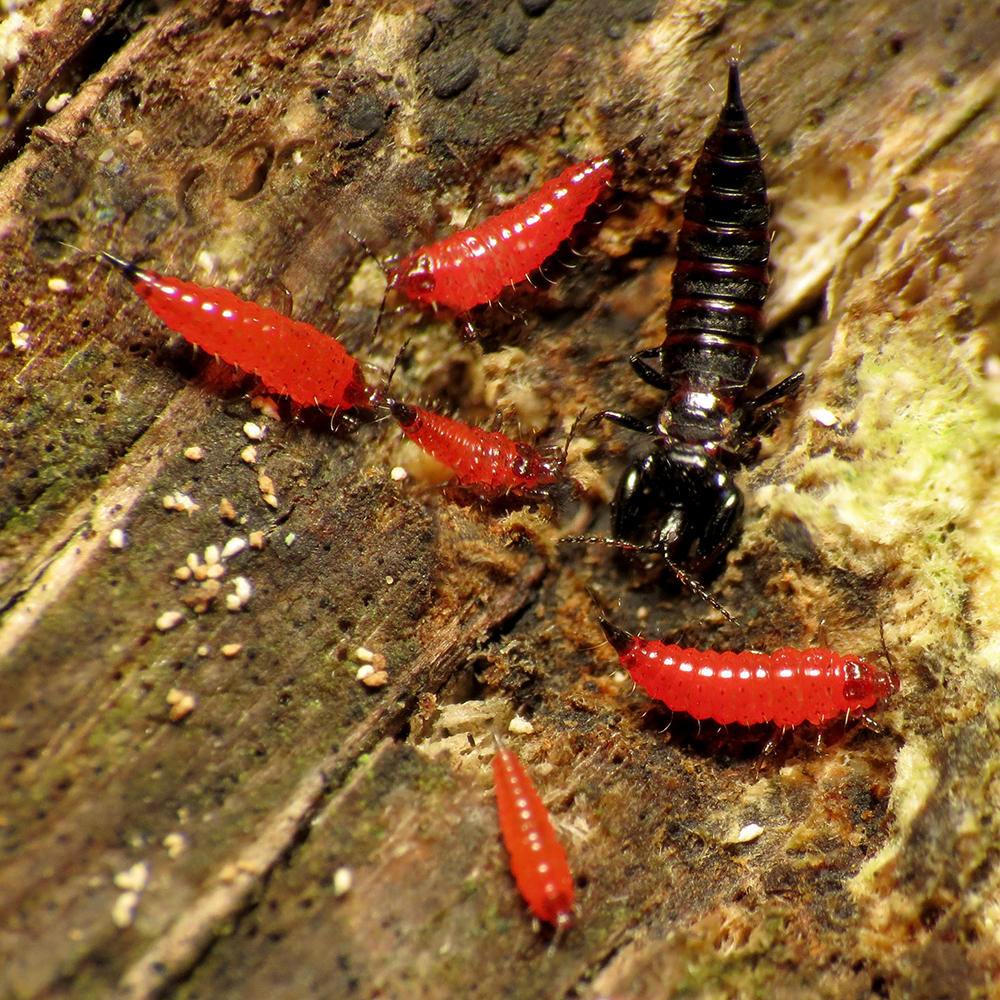
WHERE THEY ARE FOUND: Thrips live in leaf litter, under bark, in decaying trees and in fungi; non-soil-dwelling herbivorous thrips are found feeding on plants. About 50% of thrips species are found in litter, in soil or on fungi.
WHAT THEY EAT: Soil-dwelling and leaf-litter-dwelling thrips eat fungal spores, and others are predaceous on mites and small insects. Plant feeders eat leaves, fruits, flowers and buds. Most ingest food in liquid form using their piercing, sucking mouthparts.
LIFE CYCLE: Parthenogenesis, a form of asexual reproduction, can occur in many species (females are diploid, and males are haploid, as in Hymenoptera). Females insert eggs into plant tissue or under bark. The first two instars, known as larvae, are feeding stages. The third and fourth instars are nonfeeding, inactive stages during which thrips are enclosed within a silk cocoon or cell made from soil and litter particles and undergo tissue rearrangements. This stage is called a pupa, though it is unlike the pupal stage of insects with complete metamorphosis. There are numerous generations in a growing season, with some species developing from egg to adult in as little as 10 days.
APPROX. NUMBER OF KNOWN SPECIES: 6,200 worldwide (700 in North America).
RELATIVE ABUNDANCE: Thrips can occur in large numbers but specific estimate abundance in soil are not readily available.
NOTES OF INTEREST:
- Thrips’ unique metamorphosis is somewhere between simple and complete: they have internal wing development as larvae (as occurs in complete metamorphosis), but also have external growth of wing pads that occurs before the adult stage (as occurs in simple metamorphosis).
- Some plant-feeding species of thrips are serious pests of cultivated plants (e.g., many in the family Thripidae).
- Thrips’ tarsi have adhesive pads that enable them to cling to smooth surfaces.
- Winged and wingless species are dispersed long distances by wind.
- Thrips have asymmetric mouthparts.
- In American English usage, the singular form of thrips is the same as the plural.
This material is based upon work that is supported by the National Institute of Food and Agriculture, U.S. Department of Agriculture through the Sustainable Agriculture Research and Education (SARE) program. Any opinions, findings, conclusions, or recommendations expressed in this publication are those of the author(s) and should not be construed to represent any official USDA or U.S. Government determination or policy.
